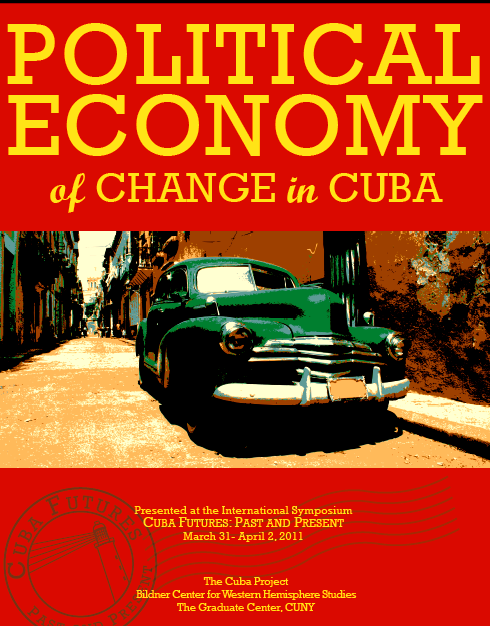By Emily Morris
Complete article here: New Left Review 88, July-August 2014
Introduction:
What is the verdict on Cuba’s economy, nearly a quarter of a century after the collapse of the Soviet bloc? The story generally told is a simple one, with a clear message. It describes a cyclical alternation of government policy between moments of pragmatic capitulation to market forces, which account for any progress, and periods of ideological rigidity and re-assertion of state control, which account for all economic difficulties. [1] After the dissolution of the Comecon trading bloc, us Cuba watchers were confident that the state-socialist economy faced imminent collapse. ‘Cuba needs shock therapy—a speedy shift to free markets’, they declared. The restoration of capitalism on the island was ‘inevitable’; delay would not only hamper economic performance but would inflict grave human costs and discredit Cuba’s social achievements. Given his stubborn refusal to embark on a course of liberalization and privatization, Fidel Castro’s ‘final hour’ had at last arrived. [2]
The problem with this account is that reality has conspicuously failed to comply with its predictions. Although Cuba faced exceptionally severe conditions—it suffered the worst exogenous shock of any of the Soviet-bloc members and, thanks to the long-standing us trade embargo, has confronted a uniquely hostile international environment—its economy has performed in line with the other ex-Comecon countries, ranking thirteenth out of the 27 for which the World Bank has full data.
……………………………
Conclusion: An alternative?
Raúl Castro’s second and final presidential term will end by 2018 at the latest. By 2016, when the five-year process of ‘updating’ under the current Guidelines comes to an end, the aim is for the economy to have a broader productive base and a larger private sector, while retaining universal health, education and welfare provision. To achieve this, the rate of investment will need to rise. Given Cuba’s success in cultivating official relations with new partners, including China, Brazil and Russia, the aspiration to increase the flow of foreign investment seems feasible. The trickier task will be to raise efficiency and dynamism within the domestic economy, while preventing widening income gaps and social divisions that threaten the state-socialist project.
Before writing off Cuba as a spent force, the magnitude of its achievement to date should be acknowledged. While conceding that market mechanisms can contribute to a more diversified and dynamic economy, Cuban policymakers have not swallowed the promises of full-scale privatization and liberalization, and have always been mindful of the social costs. This approach, shaped not least by exceptionally difficult international conditions, has been more successful in terms of both economic growth and social protection than Washington Consensus models would predict. Comparing Cuba’s experience with that of the former Comecon countries in Eastern Europe—or indeed with China and Vietnam—it is possible to identify some distinguishing features of its path.
First, Cuba was able to maintain a social safety-net during the crisis, in sharp contrast to the others. In the context of the island’s uniquely severe exogenous shock and hostile external environment, a commitment to universal welfare provision undoubtedly served to limit social hardship. Linked to this has been the process of extensive popular consultation, particularly at three critical moments—the onset of the crisis, the stabilization process, and the prelude to Raúl Castro’s new adjustment phase. Third, by retaining control of wages and prices during the early period of shock and recovery, it was possible to restore stability relatively quickly by restraining an inflationary spiral. Although fixed wages and prices created the conditions for a flourishing informal economy, they also served to minimize disruption and limit the income gap within the formal economy. Though the two are quite distinct, the strategy bears comparison with China’s ‘dual track’ system, in which the ‘planned’ track is maintained while a ‘market’ track develops alongside, providing opportunities for experimentation and learning. For all its inefficiencies and confusions, Cuba’s ‘bifurcation’ and ‘second economy’ played a part in adjustment to the new conditions.
Fourthly, the state retained control of the process of economic restructuring, allowing it to channel the very limited hard-currency resources to selected industries, achieving a remarkable recovery of foreign-exchange earnings relative to the amount of capital available. These enterprises also served as ‘learning opportunities’ for Cuban planners, managers and workers to think through how to adapt to altered international conditions. The export base created by this approach may be too narrow to drive sustainable growth over the long term, but it was an efficient way to restore capacity after the crisis period. Finally, Cuba’s rejection of the mainstream ‘transition-to-capitalism’ route allowed space for a process of adjustment—described by one official as ‘permanent evolution’ [57] —that has been flexible and responsive to Cuba’s changing conditions and constraints. This contrasts sharply with the more rigid recipes for liberalization and privatization pedalled by the hordes of transition consultants in other former Comecon countries. Cuba is a poor country, yet its health and education systems are beacons in the region. Its approach has shown that, despite contradictions and difficulties, it is possible to incorporate market mechanisms within a state-led development model with relatively positive results in terms of economic performance and social outcomes.
This raises the next question: why should we assume that the state will withdraw from its dominant role within the economy, or that the current approach to policy must eventually give way to a transition-to-capitalism path? A fundamental assumption of transition economics has been Kornai’s claim that ‘partial alteration of the system’ cannot succeed; efficiency and dynamism will only be maximized when the transformation from a ‘socialist planned’ economic system to a ‘capitalist market’ one is complete, because the former is too inflexible to survive over the long term. But the experience of former Comecon countries has demonstrated that success is far from guaranteed and that social costs can be high. Viewed without preconceptions, the Cuban case suggests that another way might be possible, after all.




